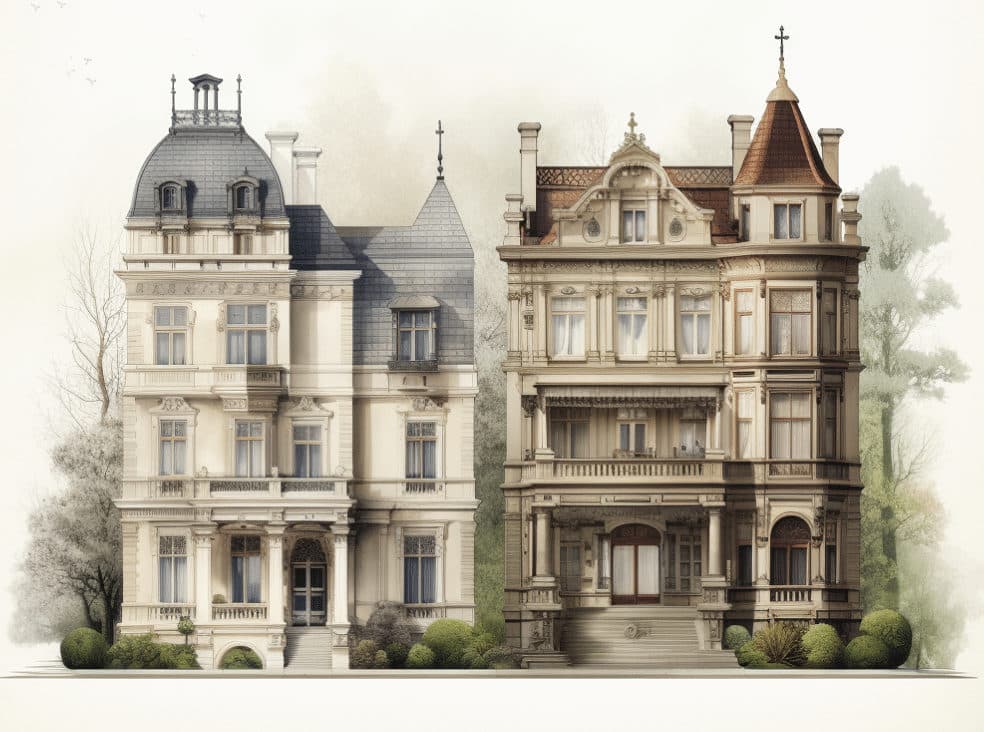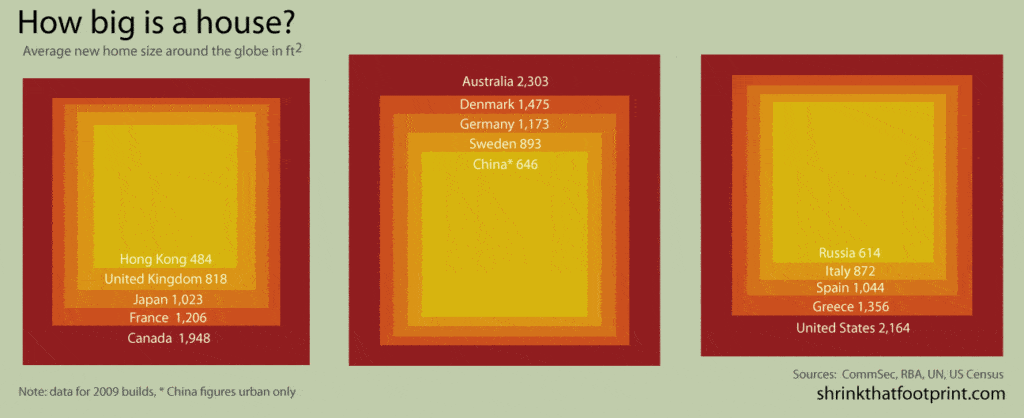Redefining “Enough Space” – Average House Size Around The World
[Updated: 01/04/2024] What is the size of your residence? Does it adequately meet your needs? Is there a globally optimal square footage per person for living spaces? This article explores the evolving dimensions of houses across the globe, and contemplates the notion of “adequate space.”

Data suggests a trend of increasing average house sizes and bigger houses contribute to a bigger home’s carbon footprint. The New York Times profiled Graham Hill’s lifestyle in a 420 square-foot (39 square-metre) apartment, a size comparable to the average homes in Hong Kong and India. Hill posited that minimalistic living is more enriching.
Critics like Christie Aschwanden pointed out Hill’s frequent travel might cancel the environmental benefits.
This brings us to an intriguing question: What is the appropriate size for a home? To answer this, we collated data from multiple sources including CommSec, RBA, UN, US Census, European Housing 2002, Australian Bureau of Statistics, Canadian Home Builders Association, Infometrics, and the Japan Statistical Yearbook.
Average House Size By Country – Graphical Comparison
To get a little perspective I’ve put together a graphic to illustrate how big the average new home is around the world. The figures are in square footage of usable floor space, and include data for both houses and flats.

In the countries I could get data for the average new home varied in size from 45 m2 (484 ft2) in Hong Kong up to 214 m2 (2,303 ft2) in Australia.
The average house size in the US was 214 m2 (2299 ft2) in 2022. The average house size in the UK is relatively small at 76 m2 (818 ft2) while the average house size in Canada is quite big at 181 m2 (1,948 ft2). For China the data only reflects urban properties, which now average 60 m2 (646 ft2) and have almost doubled in size in the last 15 years.
Table Of House Sizes By Country
The same information, updated with new sources of information is given in this table below, conveniently given house sizes in different countries using both square feet and converted to equivalent square meters as a measure of the house area.
| Country | House Size (square feet) | House Size (square meters) |
| Australia | 2303 sq. ft | 214 sq. meters |
| Austria | 1043 sq. ft | 97 sq. meters |
| Belgium | 1293 sq. ft | 120 sq. meters |
| Canada | 1948 sq. ft | 181 sq. meters |
| China | 646 sq. ft | 60 sq. meters |
| Denmark | 1475 sq. ft | 137 sq. meters |
| Finland | 880 sq. ft | 82 sq. meters |
| France | 1206 sq. ft | 112 sq. meters |
| Germany | 1173 sq. ft | 109 sq. meters |
| Greece | 1356 sq. ft | 126 sq. meters |
| Hong Kong | 484 sq. ft | 45 sq. meters |
| India | 504 sq. ft | 47 sq. meters |
| Ireland | 957 sq. ft | 89 sq. meters |
| Italy | 872 sq. ft | 81 sq. meters |
| Japan | 1023 sq. ft | 95 sq. meters |
| Luxembourg | 1359 sq. ft | 126 sq. meters |
| Netherlands | 1261 sq. ft | 117 sq. meters |
| New Zealand | 2174 sq. ft | 202 sq. meters |
| Portugal | 902 sq. ft | 84 sq. meters |
| Russia | 614 sq. ft | 57 sq. meters |
| Spain | 1044 sq. ft | 97 sq. meters |
| Sweden | 893 sq. ft | 83 sq. meters |
| United Kingdom | 818 sq. ft | 76 sq. meters |
| United States | 2164 sq. ft | 201 sq. meters |
Average US House Size Has Been Increasing Over Last 50 Years
In the US, the average house size has been increasing since the 1970s. The peak was actually in 2015 at 2467 sq ft (229 sq meters) and then it dropped slightly over the next two years. New data from 2022 indicate that things haven’t changed much – the average house size was 2,299 sq ft which still puts it below the 2015 peak.
Larger houses demand more heating and cooling. Unless increased demands are offset by gains in efficiency or renewable sources, we will see greater carbon emissions from residential energy. Also house sizes change slowly. In a span of 10 years, the average increased from 2250 to 2400 sq ft for the US.

There are other ways to mitigate both heating and cooling demands. These include better insulation, and better heating and cooling technology. On ShrinkThatFootprint we cover ways to reduce heating and cooling demands.
Average House Square Footage Of Floor Space Per Person
There are all sorts of reasons for these differences. Wealth levels, urbanization rates, land access and climate all play a part. Nonetheless the scale of the differences is pretty fascinating.
The thing that is really missing from this picture is people. We can take our analysis a little further by looking at how much floor space this equates to per person.
Using data on average household size we can estimate floor space per inhabitant for new homes. This analysis is a bit rough and ready, as it assumes new homes are being built for the average household. Nonetheless it is useful because it helps to control for the considerable differences in household size between countries.
Here are the figures in square-meters.

At just 15 m2 (161 ft2) a person in Hong Kong has just a quarter of the floor space of the average Australian or American.
The Graham Hill House Is Not So Remarkable In Certain Countries
If Graham Hill lives by himself then his trendy 39 m2 (420 ft2) is similar to someone from Sweden. In fact in the range from 30-45 m2 (323-484 ft2) are the averages for Italy, the UK, Japan, Spain, Sweden, France and Greece.
At our place we have 110 m2(1,184 ft2) for a family of four, which is 27 m2 (291 ft2) per person. Having previously lived in a few different flats of 50-60 m2 as a couple this feels pretty palatial, and is certainly more than enough for us. But 30 m2 per person is much more generous in a four person family than it is in a studio apartment for one.
London’s Minimum Space Standard
In London they have a new minimum space standard as part of the London Plan. For new flats the minimum standards are 37 m2 (398 ft2)for one person, 50 m2 (538 ft2) for two people in one bedroom, 61 m2 (657 ft2) for three people with two bedrooms, 70 m2 (753 ft2) for four people in two bedrooms and 74 m2 (797 ft2) for four people in three bedrooms. Are these enough space?
In my mind if you have decent ceiling heights, good windows, clever storage and not too much stuff a little space can go a long way.
Smaller Houses Take Less Energy To Build And Keep Habitable
A smaller home requires less embodied energy to build, has lower heating and cooling needs, needs fewer furnishings, takes less time to maintain and requires less work to fund.
In terms of carbon emissions small is beautiful. But how small is too small?
How much space do you think is enough?
Sources Of Data
There is no uniform source of data on house sizes.
Most data was curated from a select number of sources: Japan Statistical Yearbook, European Housing 2002, Australian Bureau of Statistics, Canadian Home Builders Association, Infometrics, US Census.
Data for India was obtained from a 2008 India Times article that cited a figure from a government report National Sample Survey Organization.
New Sources Of Data
Many governments publish dwelling areas for new construction. Therefore an alternative way to assess house sizes is to use only “new construction” data, which is not bad because such data is most up-to-date. The drawback is that it doesn’t reflect old construction houses in which many people live.
A compromise is to divide this article into two, with a new section that uses only statistics on new construction. The reason is that the data for new construction will tend to be better due to modern methods of record keeping.
Australia Bureau of Statistics – House size data set
US Census – Dwelling highlights
Caveats About The Data
- The data is from self-reported house sizes, which lead to inaccuracies.
- Averages include apartments and standalone houses.
- There is regional variation within each country; for instance, the U.S, with its diverse range of state-by-state housing conditions.
These limitations aside, the data provides a broad-strokes picture of worldwide housing trends.
Lindsay Wilson
I founded Shrink That Footprint in November 2012, after a long period of research. For many years I have calculated, studied and worked with carbon footprints, and Shrink That Footprint is that interest come to life.
I have an Economics degree from UCL, have previously worked as an energy efficiency analyst at BNEF and continue to work as a strategy consultant at Maneas. I have consulted to numerous clients in energy and finance, as well as the World Economic Forum.
When I’m not crunching carbon footprints you’ll often find me helping my two year old son tend to the tomatoes, salad and peppers growing in our upcycled greenhouse.
